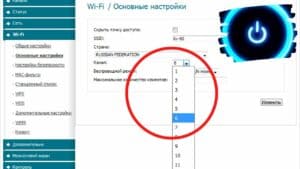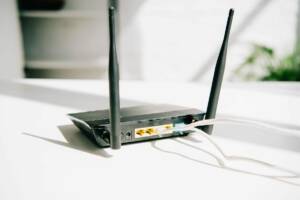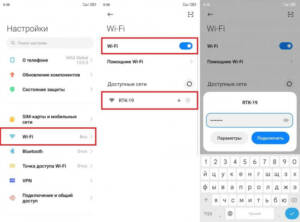- Why is it important to change the Wi-Fi channel
- How to check which Wi-Fi channel is currently in use
- Step by Step: How to Change the Wi-Fi Channel on Your Router
- Step 1: Enter your router settings
- Step 2: Find the option to change Wi-Fi channel
- Step 3: Select a new Wi-Fi channel
- Other ways to improve your Wi-Fi signal
Why is it important to change the Wi-Fi channel
A Wi-Fi channel is the frequency your router operates on. Each router has multiple channels, and unless you change it, your router will operate on the default channel. This can lead to channel congestion, which in turn can lead to slow internet speeds. Changing your Wi-Fi channel can increase your internet speed and reduce network outages. Additionally, if you live in an apartment building or near other routers, changing the channel can reduce interference between different Wi-Fi networks. Changing your Wi-Fi channel is a simple procedure, but it can significantly improve the quality of your network. In the following guide, we will tell you how to do this. Which Wi-Fi channel to choose for optimal performance
Selecting the right Wi-Fi channel on your router can help improve the performance of your wireless network. However, which Wi-Fi channel should you choose? The best option is to choose a channel that does not overlap with other channels used in your area.
There are several tools that can help you determine which channels are being used in your area. For example, you can use mobile device apps such as Wi-Fi Analyzer for Android or Wi-Fi Explorer for iOS.
Another option is to go into your router settings and manually change the channel. You can choose a channel that is not used in your area, or choose a channel that has the strongest signal.
Don't forget that depending on the model of your router, the available channels may vary. Some routers may only support the 2.4 GHz frequency, while others may support both 2.4 GHz and 5 GHz.
Ideally, if your router supports dual frequency bands, choose the 5GHz channel as it offers faster data transfer speeds.
Either way, choosing the right Wi-Fi channel can significantly improve the performance of your wireless network. Use the tools that are available to you and experiment until you find the best option for your network.
How to check which Wi-Fi channel is currently in use
As a rule, many people do not think about what Wi-Fi channel is used on their router. But this can be very important, especially if you notice that your Internet speed is slower than usual.
If you want to check which Wi-Fi channel is currently in use, then you need to go to the router settings. To do this, you need to enter your router's IP address in your browser. Typically the address looks like 192.
168.
1.
1 or 192.
168.
0.
1. If you do not know the address of your router, you can find it in the documentation or on the back panel of the router.
Once you enter the router settings, you should find the Wi-Fi section. There you will see a list of available networks and the channels they use. You can check which channel your network is using and compare it with other channels to see if it has interference or congestion.
If you notice that your network is using an overloaded or interference-affected channel, you can change it in the router settings. You can find out how to do this in our article 'How to change the Wi-Fi channel on your router: a detailed guide'.
Step by Step: How to Change the Wi-Fi Channel on Your Router
If you notice that your Internet has become slower or stopped working altogether, there may be a problem with the Wi-Fi channel settings on your router. Changing your Wi-Fi channel can improve your internet speed and stability. In this guide, we will look in detail at how to change the Wi-Fi channel on your router.
Step 1: Determine the busiest Wi-Fi channel
The first step is to determine which Wi-Fi channel is the busiest. To do this, you can use a special application such as Wi-Fi Analyzer for Android or Wi-Fi Explorer for Mac. These apps will help you find the busiest Wi-Fi channel in your area.
Step 2: Go to your router settings
Once you have identified the busiest channel, go into your router's settings. To do this, you need to enter your router's IP address in your browser. Typically, the router's IP address is listed on its back panel.
Step 3: Find Wi-Fi Settings
Once you've entered your router's settings, find your Wi-Fi settings. They are usually located in the "Wireless" or "Wi-Fi" section.
Step 4: Change Wi-Fi Channel
In Wi-Fi settings, find the “Channel” or “Channel Width” option. Select the channel that was determined to be the least busy in step 1. Save the settings and reboot the router.
After this, your Internet should work faster and more stable. If the problem persists, try changing the channel again or contact your ISP for further assistance.
Step 1: Enter your router settings
To change the Wi-Fi channel on your router, the first step is to go into the settings of the router itself. To do this, you will need to find out the IP address of your router. Usually it's 192.
168.
0.
1 or 192.
168.
1.
1. However, if you do not have this information, you can find it from your router manufacturer or use special network scanning programs.
Once you have found out your router's IP address, enter it into your browser's address bar and press Enter. An authorization window will open, where you will need to enter the username and password that you received from your Internet provider or configured yourself. If you cannot remember your username and password, contact your provider or the instructions for the router.
After successful authorization, you will be taken to your router’s settings page. Here you can configure all the settings, including the Wi-Fi channel. Typically, this option is located in the 'Wireless' or 'Wi-Fi' section. Depending on the router model, there may be differences in the interface and location of options, but usually everything is quite intuitive.
Select the 'Wireless Channel' or 'Wi-Fi Channel' tab and select the channel you want to use. It is recommended to select channels that do not overlap with other Wi-Fi networks in your area to avoid signal interference. To find out which channels are used by other networks, you can use special programs for analyzing Wi-Fi networks.
After selecting the channel, save the settings and restart the router. Now you can enjoy more stable and faster operation of your Wi-Fi network.
How to change the Wi-Fi channel on your router: a detailed guide
Step 2: Find the option to change Wi-Fi channel
Once you have entered the router settings, you need to find the option that will allow you to change the Wi-Fi channel. This option is usually found in the 'Wireless' or 'Wi-Fi' section.
If you can't find this option, try checking your router's user manual or searching online for information. If you still cannot find the option to change the Wi-Fi channel, contact your Internet service provider's technical support.
Once you have found the option to change Wi-Fi channel, select the channel you want to use. Typically routers operate on channels 1, 6, and 11, but if you live in an apartment building or in an area with a lot of wireless networks, you may want to choose a channel that is less used.
Once you have selected a channel, save your changes and reboot your router for the changes to take effect.
Changing the Wi-Fi channel can improve the stability and speed of your wireless network, especially if you live in an area with a lot of wireless networks. Try changing the Wi-Fi channel on your router and see how it affects the quality of your network.
Step 3: Select a new Wi-Fi channel
If you are facing an issue where your Wi-Fi signal is constantly cutting out, then it may be due to a Wi-Fi channel conflict in your area. To avoid this problem, you can change the Wi-Fi channel on your router.
1. Log into your router settings using your browser and your router's IP address.
2. Find the Wi-Fi settings section and select the “Channel” or “Channel” option.
3. You will be given the option to select a new Wi-Fi channel. It is recommended to select a channel that is farthest away from other channels in your area.
4. Save the settings and reboot the router for the changes to take effect.
Your Wi-Fi signal should now be more stable and reliable. Remember to check the quality of your Wi-Fi signal to make sure the Wi-Fi channel you choose is working at its best.
Once you have selected a new Wi-Fi channel for your router, you must save the changes and restart the router for them to take effect.
Saving changes depends on the model of your router, but, as a rule, the process boils down to clicking the 'Save' or 'Apply' button. Some routers may require you to enter an administrator password.
After saving the changes, you need to restart the router for the new Wi-Fi channel to start working. To do this, you can click the 'Restart' button in the router settings or simply turn it off for a few seconds and turn it on again.
After restarting the router, check that the new Wi-Fi channel is working correctly. If you notice any problems, you can always go back to the previous Wi-Fi channel or select a different one.
What to do if changing the Wi-Fi channel does not help
Changing the Wi-Fi channel on your router can help improve the stability and speed of your wireless network. However, sometimes changing the channel does not give the expected result. If you've already tried changing the channel and are still encountering problems, then there are a few things you can try.
First, make sure your router is in a good location. The router should be located in the center of your home or office, and should not be hidden behind walls or other obstacles that could weaken the signal.
Secondly, try updating your router's firmware. Some manufacturers release firmware updates that can improve the performance of your router and fix Wi-Fi problems.
Finally, if you are still encountering problems, it may be useful to try installing a Wi-Fi signal booster. A signal booster will help increase the coverage area of your wireless network and improve its stability.
Changing the Wi-Fi channel can be a useful way to improve the performance of your wireless network, but if that doesn't work, there are other steps you can take. Follow these tips to get the best Wi-Fi connection possible.
Other ways to improve your Wi-Fi signal
Changing the Wi-Fi channel isn't the only way to improve your wireless signal. Here are some other tips:
1. Install the router in the center of the house. The closer you are to your router, the stronger the signal will be, so placing your router in the center of your home can improve network coverage.
2. Avoid obstacles. Walls, metal objects, and other obstacles can weaken the Wi-Fi signal. Try to install the router in a place where there are fewer obstacles.
3. Upgrade your antenna. If your router allows you to replace the antenna, you can try installing a more powerful antenna to strengthen the signal.
4. Use repeaters. Wi-Fi repeaters can boost your signal and expand your network's coverage. Place the repeater in an area where the signal is weak to strengthen it.
Follow these tips to improve the Wi-Fi signal in your home and enjoy a fast and stable wireless network.
Read further:






